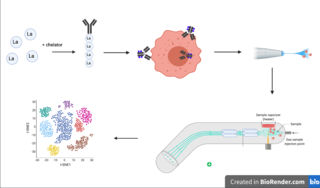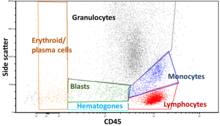
Exclusive or or exclusive disjunction or exclusive alternation, also known as non-equivalence which is the negation of equivalence, is a logical operation that is true if and only if its arguments differ.
In computer science, program analysis is the process of automatically analyzing the behavior of computer programs regarding a property such as correctness, robustness, safety and liveness. Program analysis focuses on two major areas: program optimization and program correctness. The first focuses on improving the program’s performance while reducing the resource usage while the latter focuses on ensuring that the program does what it is supposed to do.
In statistics, a k-thpercentile, also known as percentile score or centile, is a score below which a given percentage k of scores in its frequency distribution falls or a score at or below which a given percentage falls. Percentiles are expressed in the same unit of measurement as the input scores, not in percent; for example, if the scores refer to human weight, the corresponding percentiles will be expressed in kilograms or pounds. In the limit of an infinite sample size, the percentile approximates the percentile function, the inverse of the cumulative distribution function.

Flow cytometry (FC) is a technique used to detect and measure physical and chemical characteristics of a population of cells or particles.

In biochemistry, immunostaining is any use of an antibody-based method to detect a specific protein in a sample. The term "immunostaining" was originally used to refer to the immunohistochemical staining of tissue sections, as first described by Albert Coons in 1941. However, immunostaining now encompasses a broad range of techniques used in histology, cell biology, and molecular biology that use antibody-based staining methods.
Data-flow analysis is a technique for gathering information about the possible set of values calculated at various points in a computer program. A program's control-flow graph (CFG) is used to determine those parts of a program to which a particular value assigned to a variable might propagate. The information gathered is often used by compilers when optimizing a program. A canonical example of a data-flow analysis is reaching definitions.
In computer science, a parallel random-access machine is a shared-memory abstract machine. As its name indicates, the PRAM is intended as the parallel-computing analogy to the random-access machine (RAM). In the same way that the RAM is used by sequential-algorithm designers to model algorithmic performance, the PRAM is used by parallel-algorithm designers to model parallel algorithmic performance. Similar to the way in which the RAM model neglects practical issues, such as access time to cache memory versus main memory, the PRAM model neglects such issues as synchronization and communication, but provides any (problem-size-dependent) number of processors. Algorithm cost, for instance, is estimated using two parameters O(time) and O(time × processor_number).

In software engineering, structured analysis (SA) and structured design (SD) are methods for analyzing business requirements and developing specifications for converting practices into computer programs, hardware configurations, and related manual procedures.
In computer science, the earth mover's distance (EMD) is a distance-like measure of dissimilarity between two frequency distributions, densities, or measures over a region D. For probability distributions and normalized histograms, it reduces to the Wasserstein metric . Informally, if the distributions are interpreted as two different ways of piling up earth (dirt) over the region D, the EMD captures the minimum cost of building the smaller pile using dirt taken from the larger, where cost is defined as the amount of dirt moved multiplied by the ground distance over which it is moved.

A functional flow block diagram (FFBD) is a multi-tier, time-sequenced, step-by-step flow diagram of a system's functional flow. The term "functional" in this context is different from its use in functional programming or in mathematics, where pairing "functional" with "flow" would be ambiguous. Here, "functional flow" pertains to the sequencing of operations, with "flow" arrows expressing dependence on the success of prior operations. FFBDs may also express input and output data dependencies between functional blocks, as shown in figures below, but FFBDs primarily focus on sequencing.
CASY technology is an electric field multi-channel cell counting system. It was first marketed by Schärfe System GmbH in 1987 under the name CASY1. The first systems were sold with an ATARI computer and a rectangular chassis. In the 1990s the ATARI computer got replaced by a common PC and the chassis changed into cylinders. In 2006, Schärfe System was acquired by Innovatis AG, a company focused on cell culture analysis. CASY utilizes the techniques of electric current exclusion and pulse area analysis, the cells can be analyzed and counted in an efficient and precise manner. This technology can be applied for cell counting, cell culture analysis at a certain time interval, or even a period of time.
FlowJo is a software package for analyzing flow cytometry data. Files produced by modern flow cytometers are written in the Flow Cytometry Standard format with an .fcs file extension. FlowJo will import and analyze cytometry data regardless of which flow cytometer is used to collect the data.
LabKey Server is a software suite available for scientists to integrate, analyze, and share biomedical research data. The platform provides a secure data repository that allows web-based querying, reporting, and collaborating across a range of data sources. Specific scientific applications and workflows can be added on top of the basic platform and leverage a data processing pipeline.

Cytometry by time of flight, or CyTOF, is an application of mass cytometry used to quantify labeled targets on the surface and interior of single cells. CyTOF allows the quantification of multiple cellular components simultaneously using an ICP-MS detector.

Mass cytometry is a mass spectrometry technique based on inductively coupled plasma mass spectrometry and time of flight mass spectrometry used for the determination of the properties of cells (cytometry). In this approach, antibodies are conjugated with isotopically pure elements, and these antibodies are used to label cellular proteins. Cells are nebulized and sent through an argon plasma, which ionizes the metal-conjugated antibodies. The metal signals are then analyzed by a time-of-flight mass spectrometer. The approach overcomes limitations of spectral overlap in flow cytometry by utilizing discrete isotopes as a reporter system instead of traditional fluorophores which have broad emission spectra.
Flow cytometry bioinformatics is the application of bioinformatics to flow cytometry data, which involves storing, retrieving, organizing and analyzing flow cytometry data using extensive computational resources and tools. Flow cytometry bioinformatics requires extensive use of and contributes to the development of techniques from computational statistics and machine learning. Flow cytometry and related methods allow the quantification of multiple independent biomarkers on large numbers of single cells. The rapid growth in the multidimensionality and throughput of flow cytometry data, particularly in the 2000s, has led to the creation of a variety of computational analysis methods, data standards, and public databases for the sharing of results.
Flow Cytometry Standard (FCS) is a data file standard for the reading and writing of data from flow cytometry experiments. The FCS specification has traditionally been developed and maintained by the International Society for Advancement of Cytometry (ISAC). FCS used to be the only widely adopted file format in flow cytometry. Recently, additional standard file formats have been developed by ISAC.

Cache hierarchy, or multi-level caches, refers to a memory architecture that uses a hierarchy of memory stores based on varying access speeds to cache data. Highly requested data is cached in high-speed access memory stores, allowing swifter access by central processing unit (CPU) cores.
Photoacoustic flow cytometry or PAFC is a biomedical imaging modality that utilizes photoacoustic imaging to perform flow cytometry. A flow of cells passes a photoacoustic system producing individual signal response. Each signal is counted to produce a quantitative evaluation of the input sample.








